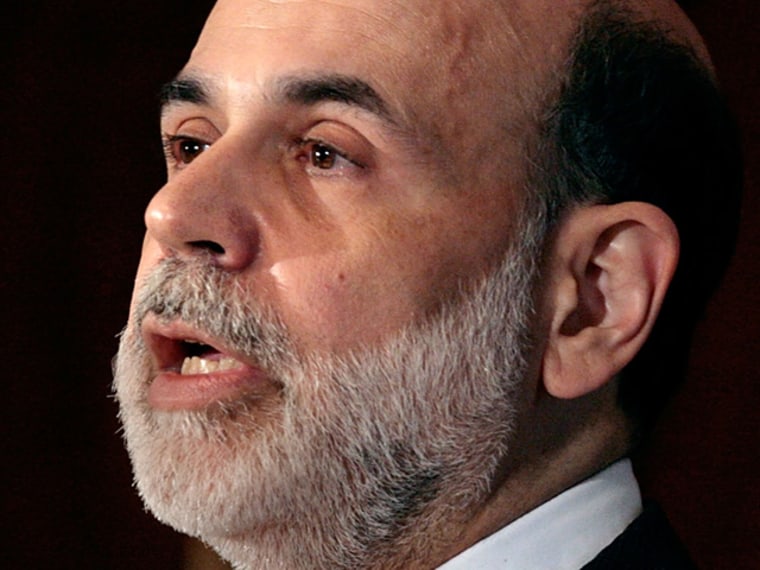Straddling risky economic crosscurrents, the Federal Reserve is expected to stand still this week on interest rates.
Fed Chairman Ben Bernanke and his colleagues, who open a two-day meeting Tuesday, are in a tricky spot: they are faced with stuck-in-a-rut economic growth along with inflation threats from rising prices for energy, food and other commodities. Fed officials have made clear that because of concern about inflation, they're not inclined to cut rates further. At the same time, they have recognized that pushing rates up too soon could undermine an economy buffeted by housing, credit and financial woes.
"These are very challenging waters to have to navigate," said economist Richard Yamarone at Argus Research.
Against that backdrop, the Fed is almost certain to hold its key interest rate steady at 2 percent when it wraps up its session on Wednesday. If that's the case, the prime lending rate for millions of consumers and businesses would stay at 5 percent. The prime rate applies to certain credit cards, home equity lines of credit and other loans.
Wall Street investors and a few economists believe inflation problems might force the Fed to start boosting rates in August or later this year. However, many others think that's a situation the Fed would like to avoid — especially given that the housing market is still flailing and foreclosures are at record highs.
Mortgage rates are already rising — spurred higher by investors' concerns about inflation. And, those higher rates spell yet more headaches for the problem-plagued housing market.
"It's an extremely hard place for the Fed," said Susan Wachter, a professor of real estate and finance at the University of Pennsylvania's Wharton School of Business.
So what's the Fed to do?
"Tread lightly on rates and carry a big rhetorical anti-inflation stick," said Ken Mayland, president of ClearView Economics.
In a string of speeches over the past few weeks, Bernanke and his colleagues have been doing just that. They've ramped up their tough anti-inflation talk to rein in inflation expectations of consumers, investors and businesses. If those groups think prices will keep on rising, they'll act in ways that can worsen inflation.
And, Bernanke, in a rare public utterance for a Fed chief, sounded a warning against the slide in the U.S. dollar contributing to an unwelcome rise in inflation. He sought to use words — versus action — to bolster the dollar and try to lessen inflation pressures.
Consumer prices in the first five months of this year have risen at an annual rate of 4 percent. That's down from a 4.1 percent increase last year — the biggest jump in 17 years — but is still too high for the Fed's liking. Gasoline prices and oil prices have set a string of record highs. Gas has topped $4 a gallon, while oil prices are hovering around $134 a barrel.
Economists predict the Fed's policy statement, released Wednesday, probably will go further in highlighting inflation risks but won't go as far as to signal a rate increase at the Fed's next meeting on Aug. 5.
With any luck, if the Fed is successful with this strategy, it might be able to hold rates at current levels through the rest of this year and won't have to start to boost them until next year, some economists said.
That would give the economy more time to gain traction. The Fed is hoping that its powerful series of rate cuts and the government's $168 billion stimulus package will help energize the economy later this year and into 2009. The Fed launched its rate-cutting campaign last September and ordered its most recent reduction in late April. Those lower rates take months to work their way through the economy, however.
Mayland said he believes damage and business disruptions from the Midwestern floods will add to the economy's weakness — another reason why he and others think the Fed will be holding rates steady through the rest of this year.
The economy has grown at a snail's pace in recent months. And, employers have cut jobs every month so far this year. The unemployment rate jumped to 5.5 percent in May, from 5 percent in April, the largest one-month increase in two decades. The unemployment rate is expected to keep on rising in the months ahead — even if economic growth improves somewhat.
Donald Kohn, the Fed's No. 2 official, recently said that in the short term, it may be that some rise in both inflation and unemployment will have to be tolerated.
Setting interest rates "in a manner that balances the undesirable effects of a shock to the system on both inflation and employment will tend to be more efficient than setting policy so as to deliver more extreme outcomes in either inflation or unemployment," Kohn said.
